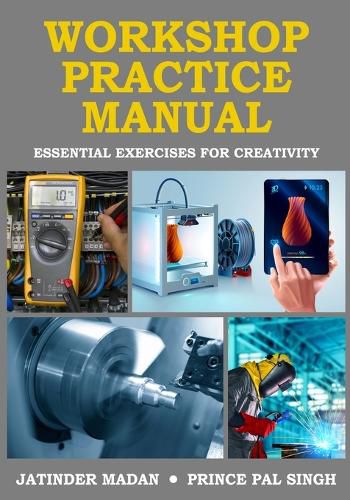Readings Newsletter
Become a Readings Member to make your shopping experience even easier.
Sign in or sign up for free!
You’re not far away from qualifying for FREE standard shipping within Australia
You’ve qualified for FREE standard shipping within Australia
The cart is loading…






This title is printed to order. This book may have been self-published. If so, we cannot guarantee the quality of the content. In the main most books will have gone through the editing process however some may not. We therefore suggest that you be aware of this before ordering this book. If in doubt check either the author or publisher’s details as we are unable to accept any returns unless they are faulty. Please contact us if you have any questions.
Workshop practice course is introduced in undergraduate engineering programs to the freshman in several countries. The objective of this course is to provide the students a practice-based exposure to the most basic manufacturing or workshop processes, such as carpentry, fitting, foundry (or casting), welding, sheet metal, electrical, electronics, smithy and forging, and machining. Although there have been notable developments in the manufacturing technologies, with many new manufacturing processes being introduced, aforementioned processes are still relevant and important to understand newer processes. Therefore, exposure to the workshop practices is required for the students in their first year of engineering programs. Power tools, such as hand drills are also important to perform many tasks. Further, in recent years, additive manufacturing or 3D printing technologies have also gained importance, which also needs to be introduced to the students in their first year itself so that they can use it for exercising creativity in remaining years of their engineering program. The book covers above mentioned conventional workshop practices, power tools and 3D printing.
This book is about practice. Therefore, selected practical exercises are given at the end of each chapter along with the detailed procedure. A response sheet where the learners can answer to specific questions after they complete the given exercise has also been provided. A lot of illustrations have been used in the book for clarity and understanding to make the learning experience enjoyable.
$9.00 standard shipping within Australia
FREE standard shipping within Australia for orders over $100.00
Express & International shipping calculated at checkout
This title is printed to order. This book may have been self-published. If so, we cannot guarantee the quality of the content. In the main most books will have gone through the editing process however some may not. We therefore suggest that you be aware of this before ordering this book. If in doubt check either the author or publisher’s details as we are unable to accept any returns unless they are faulty. Please contact us if you have any questions.
Workshop practice course is introduced in undergraduate engineering programs to the freshman in several countries. The objective of this course is to provide the students a practice-based exposure to the most basic manufacturing or workshop processes, such as carpentry, fitting, foundry (or casting), welding, sheet metal, electrical, electronics, smithy and forging, and machining. Although there have been notable developments in the manufacturing technologies, with many new manufacturing processes being introduced, aforementioned processes are still relevant and important to understand newer processes. Therefore, exposure to the workshop practices is required for the students in their first year of engineering programs. Power tools, such as hand drills are also important to perform many tasks. Further, in recent years, additive manufacturing or 3D printing technologies have also gained importance, which also needs to be introduced to the students in their first year itself so that they can use it for exercising creativity in remaining years of their engineering program. The book covers above mentioned conventional workshop practices, power tools and 3D printing.
This book is about practice. Therefore, selected practical exercises are given at the end of each chapter along with the detailed procedure. A response sheet where the learners can answer to specific questions after they complete the given exercise has also been provided. A lot of illustrations have been used in the book for clarity and understanding to make the learning experience enjoyable.